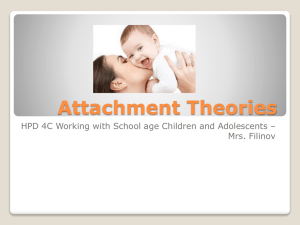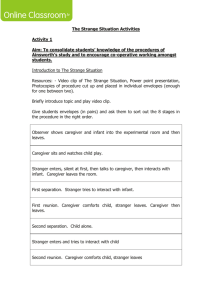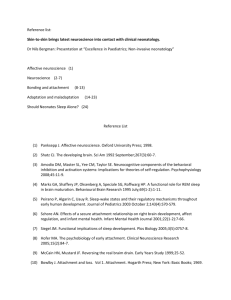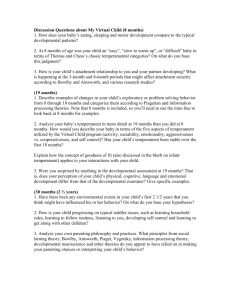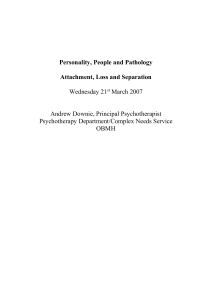Running head: BOWLBY'S ATTACHMENTS (CHILDHOOD
advertisement
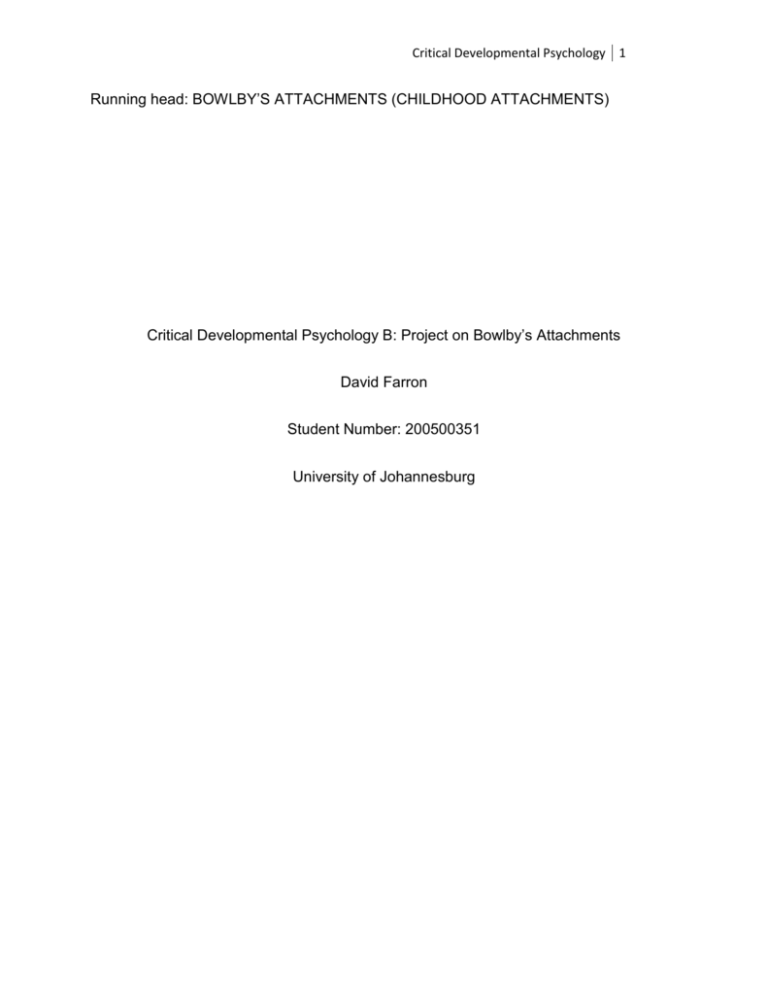
Critical Developmental Psychology 1 Running head: BOWLBY’S ATTACHMENTS (CHILDHOOD ATTACHMENTS) Critical Developmental Psychology B: Project on Bowlby’s Attachments David Farron Student Number: 200500351 University of Johannesburg Critical Developmental Psychology 2 Page of Content 1. Introduction……………………………………………………………..page 4 2. Background to Bowlby’s Theory………………………………..……..page 4 3. Theories of Attachment ………………………………………………..page 4 3.1. Psychoanalytic Theory……………………………………………page 5 3.2. Learning Theory……………………………………………………page 5 3.3. Cognitive-Development Theory…………………………………..page 5 3.4. Ethological Theory…………………………………………………page 6 4. Importance of Attachment ………………………………………….....page 6 5. Phases of Attachment………………………………………………….page 7 5.1. Phase 1…………………………………………………………..page 7 5.2. Phase 2…………………………………………………………..page 7 5.3. Phase 3…………………………………………………………..page 8 5.4. Phase 4…………………………………………………………..page 9 6. Separation………………………………………………………………page 9 7. Conclusion……………………………………………………………...page 10 8. Reference List…………………………………………….…………….page 11 Critical Developmental Psychology 3 Critical Developmental Psychology 4 Abstract John Bowlby was a psychologist who began to analyze and form theories on childhood attachments. His theory is known as the “Attachment Theory” and it is in this theory that the bond and attachment between the child and the primary caregiver is analyzed. Bowlby describes four separate phases of attachments and analyzes the child’s expected behavior and expectations in these four phases. Bowlby also makes a crucial discovery and shows how children, at a certain level, use their primary caregiver as secure base from which to explore the world. Critical Developmental Psychology 5 1. Introduction Since the field of Developmental Psychology was founded and analyzed, there has been a huge emphasis and desire to learn about how children form attachments to their parents and how these attachments influence their future behavior and relationships. Bowlby describes attachment as “a lasting psychological connectedness between human beings” (Radebe, 2006). Therefore all behavior associated with attachment is aimed at preserving or improving the proximity a child has towards their caregiver. Attachments involve a continuous relationship a child has with their caregiver and involve attributes such as warmth and intimacy. It is through this project that I will analyze the work done by Bowlby in this field and the results of his theories. 2. Background to Bowlby’s Theory Bowlby was very interested in affectional bonds, separation, anxiety, grief and mourning, and unconscious mental processes between children and their parents. Bowlby believed that in order to study the development of a person, one should study the environment in which that person was raised. Bowlby therefore looked at institutions such as orphanages and child guidance centers and noticed that the kids raised in these institutions had an inability to form intimate relationships with other people as the mother-infant bond was never there. There are attachment behaviors such as crying, smiling, grasping, sucking etc… that a child must learn and receive a response in order to learn how to become attached to another individual. The child’s future attachments and relationships are based on the responses they receive from their primary caregiver. It is through this examination that Bowlby also theorized his theory of the Secure Base (Radebe, 2006). 3. Theories of Attachment Pets can be seen to form attachments with their owners and appear to be very responsive and loving towards their owner who feeds them and looks after them, so are Critical Developmental Psychology 6 humans the same? There are four theories of attachment and each one will now be described. (Shaffer, 2002) 3.1. Psychoanalytic Theory This theory is based on Sigmund Freud’s theories and ideas. Freud believes that young children have an oral fixation and most pleasure and satisfaction they receive comes from their oral pleasure they are provided. Through the primary caregiver feeding the infant, the infant attaches himself to the caregiver and looks to the caregiver for happiness and safety. Erik Erikson went on to state that mother’s feeding practices will increase the closeness and attachment between the mother and the child. This theory can basically be summed up the child loving the caregiver because the caregiver feeds him. ((Shaffer, 2002) 3.2. Learning Theory This theory states that infants learn to associate love and attachment with their mother as it is their mother who feeds them and provides them with comfort. Through their learning that their mother is a source of love and comfort they begin to become reliant on their mother and love back. Once the primary caregiver has been given the status of the “secondary reinforecer” (Shaffer, 2002; 390) the infant is officially attached and now cries, babbles, smiles, etc… in order to receive positive reinforcement from the caregiver. Experiments were preformed with monkeys to asses’ weather a baby monkey will be more attracted to a soft and cuddly warm cloth mother, or to a cloth mother that simply fed him. The results showed that the monkey is more attracted to the cloth mother. This shows how animals systematically learn to love a caregiver that is warm and loving. (Shaffer, 2002) 3.3. Cognitive Developmental Theory This theory explains attachments as a conscious thought process that goes through the mind of the infant. After about six months, the infant begins to recognize familiar faces and discriminate and form biases as to who he perceives as familiar and loving and who he does not. It was found that only when a child reaches the age of approximately nine Critical Developmental Psychology 7 month old, is he able to form an attachment to his primary caregivers. This theory advocates that in order for an attachment to occur, the child must consciously and cognitively know that his caregiver is there for him in order to form an attachment and love the caregiver back. (Shaffer, 2002) 3.4. Ethological Theory This theory states that emotional attachments are possibly there due to powerful and dominant evolutionary factors. This theory is the one that John Bowlby uses when he describes attachments and is the standpoint for his theory. The theory states that the attachment itself is thought to have adaptive values as it guarantees the safety and unconditional love a baby needs in order to survive. This theory complies with Darwinian theory of “survival of the fittest” and shows that it is human nature to attach themselves to their primary caregiver in order to produce a successful generation and keep surviving. (Shaffer, 2002). This theory is very important in Bowlby’s attachment theory and will be described in the following section of this project. 4. Importance of Attachment John Bowlby believed that attachment is crucial for humans. Bowlby based a lot of his theories on the Darwinian Approach towards understanding human nature. He therefore believed that human interaction is a very important component in the survival of humans. An infant’s survival in this world is therefore based upon his ability to communicate and form a close attachment with his primary caregiver. It is through this attachment that the child will be protected and enabled to grow and discover new experiences. (Ainsworth, Blehar, Waters & Wall) Humans are born incredibly premature by nature and they are very dependent on their primary caregivers. It is therefore crucial, and makes sense, that children form a bond with their caregivers in order to survive. Bowlby believes that as humans grow up they need to have relationships and bonds with other humans as it is human nature to never want to be alone and to fear loneliness. This illustrates how important learning to attach to other individuals is as this shapes our future relationships. (Bowlby, 1988) Critical Developmental Psychology 8 5. Phases of Attachment Bowlby states that there are (particular) critical periods of sensitivity for bonding. There are four phases of attachment that take place from birth, until the end of childhood. Each phase represents a new different period in the child’s life in which the child is at a certain stage and ready to receive different forms of attachment. (Bowlby, 1988) 5.1. Phase 1 The first phase of attachment takes place from birth – three months of age. This phase of attachment is known as “Indiscriminate Responsiveness to Humans” (Radebe, 2006) or “The Initial Pre-attachment Phase” (Ainsworth, Blehar, Waters & Wall). At the very beginning of a child’s life, the child exhibits responses towards other humans. However these responses are not biased or discriminatory at all and are completely unselective. The baby has not formed a personal attachment to any particular person yet and therefore has no preference in responding to any human. In approximately the first five-six weeks smiles and other responses are produced, but only briefly. It is after roughly 6 weeks old that a baby actually begins making eye contact with other humans and smiles when they see other human, but at this early stage of development, the baby has no preference as to which human the baby smiles at. Bowlby holds the opinion that the act of smiling promotes and allows for attachment to take place as it guarantees the proximity of the caregiver. Proximity of the caregiver can be, and is assured through other behaviors such as crying and babbling. These behaviors promote attachment as they exhibit a response from the caregiver and a relationship is formed or strengthened. (Radebe, 2006) 5.2. Phase 2 The second phase of attachment takes place from three - six months of age. This phase of attachment is known as “Focusing on Familiar People” (Radebe, 2006) or “The Phase of Attachment in The Making” (Ainsworth, Blehar, Waters & Wall). It is in this phase and stage of a baby’s life that their social responses become more selective and favoritism begins to occur as to what behaviors will be performed in front of which people. The baby will progressively restrict its smiles to people that he is familiar with Critical Developmental Psychology 9 and begins to only babble in the presence of familiar faces. It is in this phase that the infant takes preferences and identifies his primary attachment figure or the primary caregiver. The primary caregiver is normally the mother, but can also be the father on occasion. The primary caregiver is the person who the child perceives to respond most consistently and regularly to his behaviors and signs. (Radebe, 2006) 5.3. Phase 3 The third phase takes place from six months – three years of age and is known as “Intense Attachment and Active Proximity-Seeking” (Radebe, 2006) or “The Phase of Clear-cut Attachment” (Ainsworth, Blehar, Waters & Wall). By the age of six months, the child’s attachment and openness to people has become very limited and exclusive towards a select few people. Towards the few people, or single person, the attachment now becomes very intense as most infants cry when their attachment figure leaves the room and show great joy and happiness on the attachment figure returning. This may actually be so intense that separation anxiety sometimes exists. After approximately eight months, the child potentially begins to display a fear of strangers as the baby has such a great and immense attachment towards their primary caregiver. This immense attachment becomes even more evident when at approximately eight months the child begins to crawl and then usually actively attempts to follow the parent. Most likely the baby will attempt to be in proximity of the caregiver and then signal that he wants to be picked up, and once this has happened the child will be at ease and tranquil. (Radebe, 2006) It is during this phase that Bowlby made a crucial discovery. Bowlby observed that babies use their primary caregiver as a secure base from which to explore. This can be seen from when babies actively begin to explore their environment. When analyzing a babies initial exploration of their environment, the baby eventually leaves his caregivers side to play, but returns to the caregivers side every once in a while and consistently looks back and glances at the caregiver and makes sure she is still there. (Radebe, 2006) Critical Developmental Psychology 10 By the end of the first twelve months of the child’s life, the child has formulated a model of his relationship with the attachment figure. The child now has expectations about the attachment figure and knows when and how to communicate with that figure. This is where Bowlby’s Attachment Theory explains behavior as the theory hypothesis and tries to show that a child who believes that his mother is and will always be there for him when he needs her will explore new situations and be comfortable to investigate new experiences. However, a child who perceives his primary caregiver as unavailable and not engages with him, will be anxious and nervous about exploring the world when away from the caregiver. (Radebe, 2006) 5.4. Phase 4 The final phase takes place from the child being three years old and ends with the end of childhood. This phase is known as “Partnership Behavior” (Radebe, 2006) or “The Phase of a Goal-corrected Partnership” (Ainsworth, Blehar, Waters & Wall). By the time the child is three; he can now actually empathize with the caregiver and realizes that the caregiver has her own plans. The child also begins to envisage the caregiver while the caregiver is not there. The parent therefore begins to act like a partner in the relationship as the child begins to allow the parent to leave his side and live their own lives to an extent. This phase is very gradual and involves and involves the child consistently becoming more independent as time goes on. (Radebe, 2006) 6. Separation Bowlby was a strong believer that separation from the primary caregiver does indeed have an enormous impact on the child. When the separation process does actually take place the following stages take place in order: protest; despair; and detachment. The first stage involves the child complaining, whining etc… in order to prevent the separation from occurring. The Second stage involves the child simply being saddened and demoralized about the separation but accepting it. The final stage involves the separation taking place. (Radebe, 2006) Critical Developmental Psychology 11 7. Conclusion Bowlby was the first scholar to actually analyze the attachment of children to their parents and the psychological implications the relationship will have on their future relationships. Through his work he devised phases in which certain attachment behaviors take place. Bowlby is truly the catalyst on the attachment theory and his theory and analysis led to much w\more work and experimentation done on the topic. Critical Developmental Psychology 12 Reference List Ainsworth, M. D. S., Blehar, M. C., Waters, E., & Wall, S. (1978). Patterns of Attachment: A Psychological Study of the Strange Situation. New Jersey: Lawrence Filbaum Associates, Publishers Hilsdale. Bowlby, J. (1988). A Secure Base: Parent-Child Attachment and Healthy Human Development. Shaffer, D. R. (2002). Developmental Psychology: Sixth Edition. Belmont: Thomson Learning Inc. Child and Family Psychology 2A: Reader for KLS2A11. Compiled by Ms. N.B. Radebe. University of Johannesburg. 2006.


